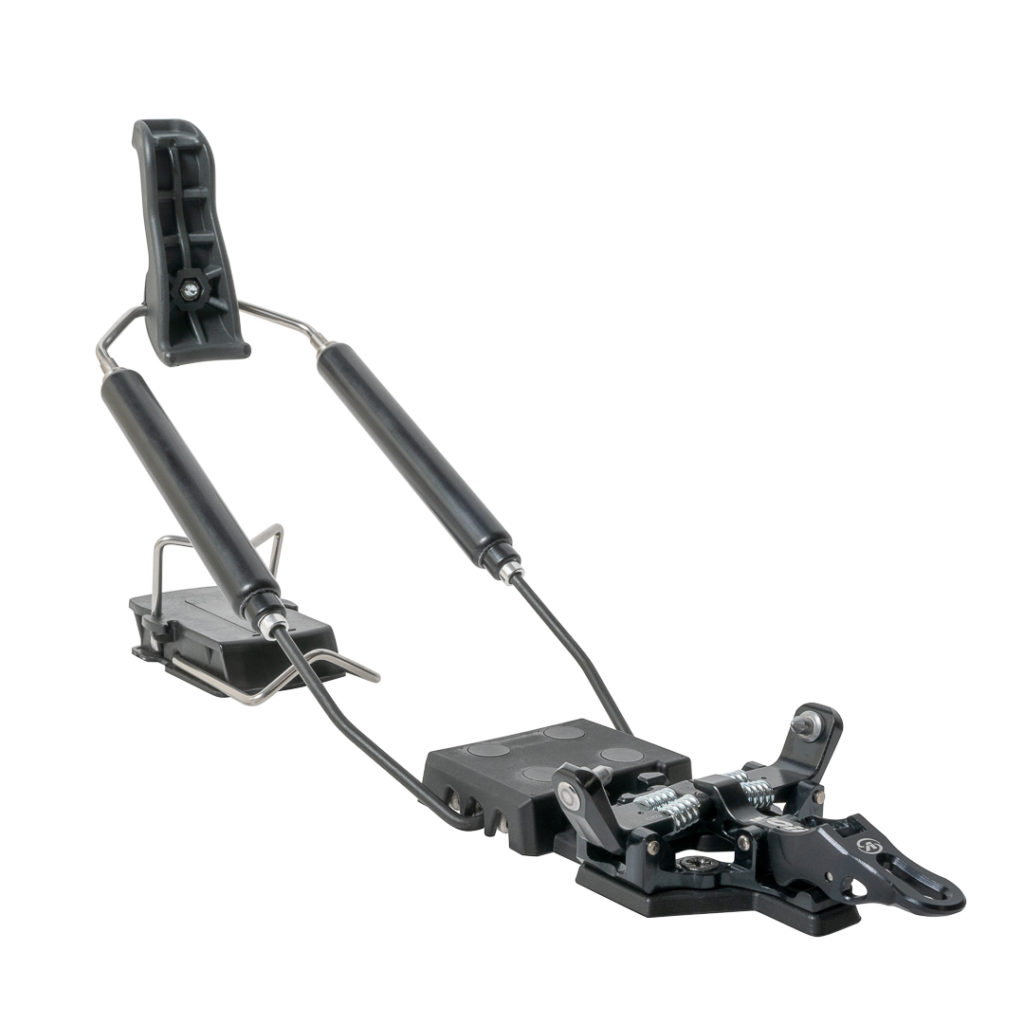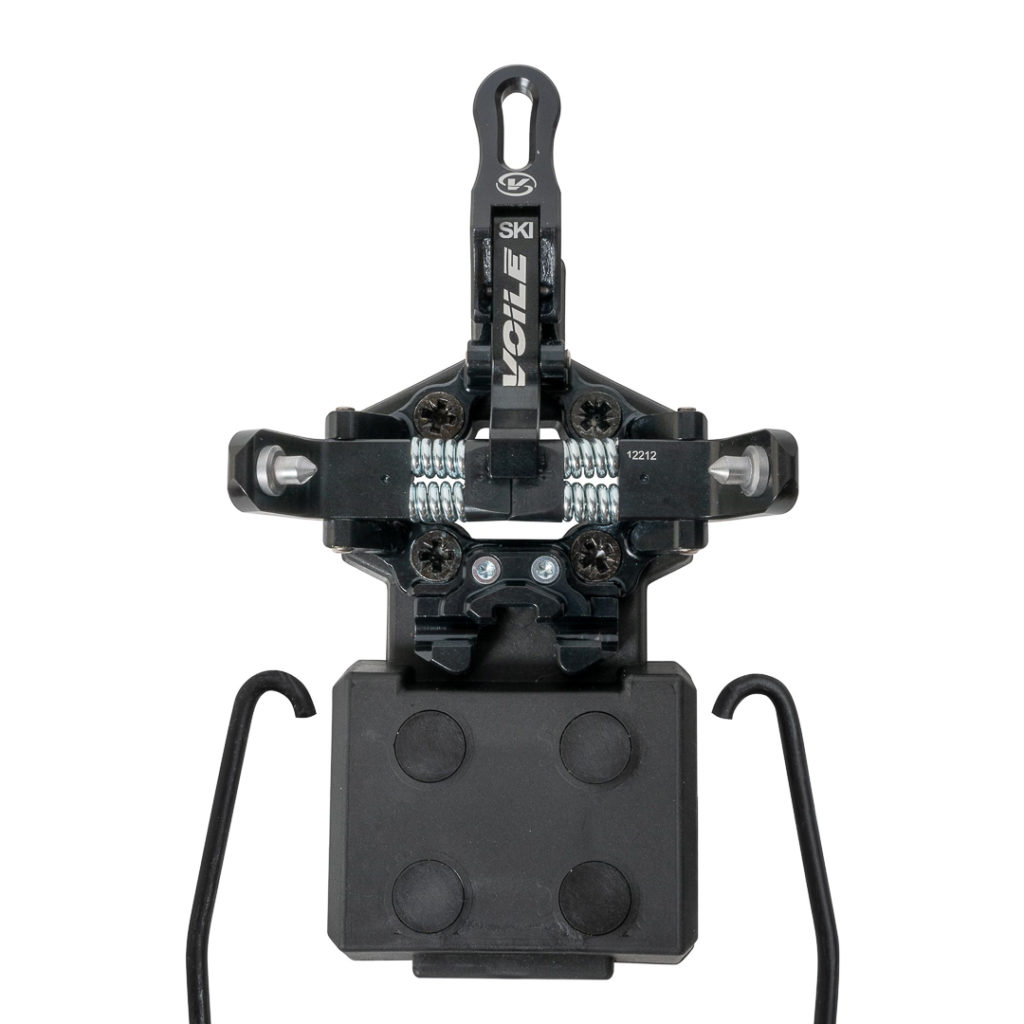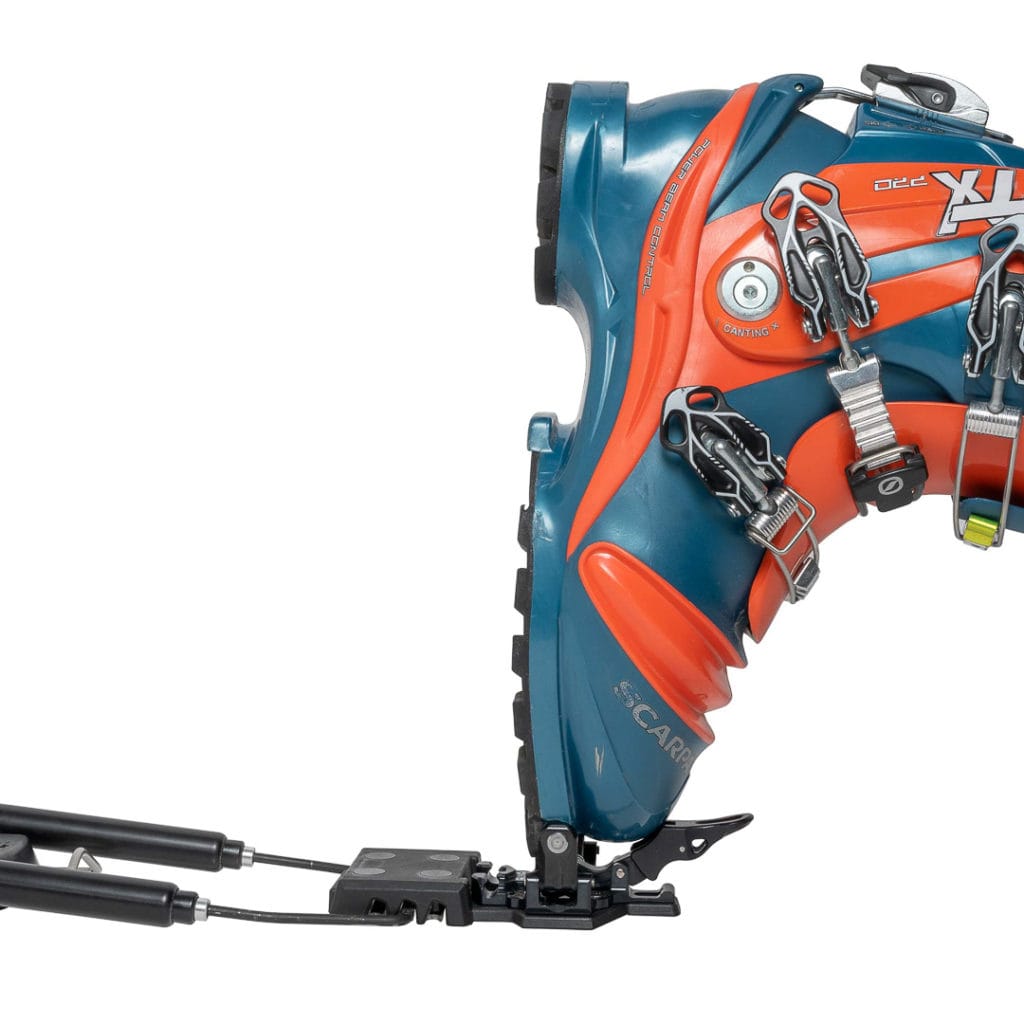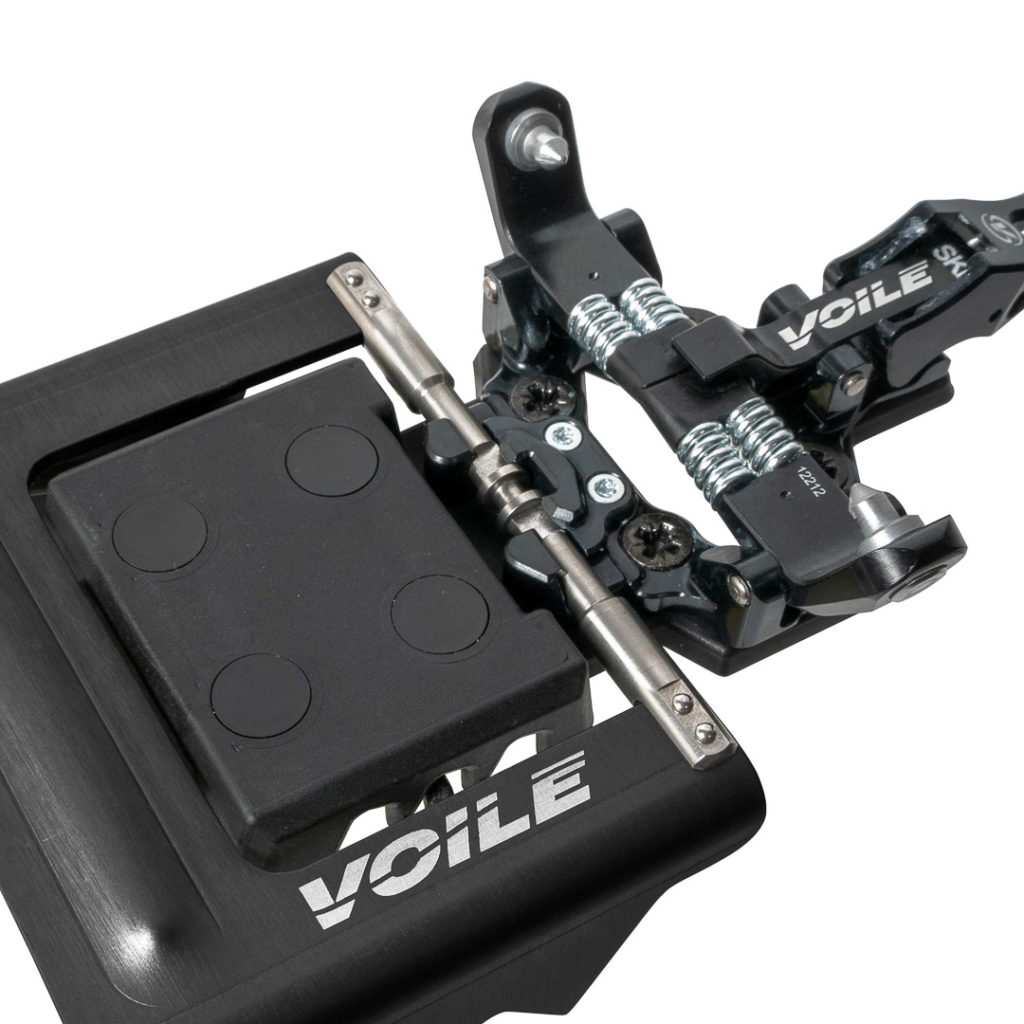
The 2nd gen Voile Transit TTS—like telemark tech systems in general—is a marriage of new-age: Dynafit touring capability and the old cable/cartridge connection of classic 75mm bindings. Photo: Voile
Since, well, a long time now, tele skiers have awaited the next best thing in gear evolution. Jack O’Brien, of Telemark Voices, thinks the tele-end-times aren’t imminent. Enter the soon-to-be-released 2nd gen Voile TTS binding.
Telemark skiing is now forever linked to the tech toe. No matter how much power cage-toe NTN (the burly, plate-to-foot connected, cable-less new telemark norm for the uninitiated) might give you, or how much you love your T2s (long live duckbill boots), the tech toe offers the best touring and arguably the best skiing bindings telemark has yet seen.
The second-generation binding from Voile, the TTS Transit Binding, is the latest innovation in tech-toe telemark. It continues the legacy of great skiing coming from a (two) pin free-heel setup, further solidifying that the future of telemark is firmly in the tech toe camp, regardless of which norm (spoiler: there’s already more than one). Maybe more importantly, Voile’s mature design is the first of its kind to be widely available and in a turnkey, non-DIY version. This binding iteration could be just what the sport needs to move manufacturers toward filling wide voids in telemark’s other gear offerings.
Tele Binding History in a Snapshot
Telemark gear has taken a circuitous route to the tech-toe. The piece of alpine touring equipment that arguably robbed telemark of its status as the backcountry binding of choice now sits snugly on many a free-heel binding. But that path was anything but guaranteed. Fifteen years ago, few would have dreamed that the pincer toe piece, first invented by maestro Fritz Barthel all the way back in the 80s and licensed to Dynafit in 1990, could withstand the pivoting and cranking from a telemark turn. But decades of DIY tinkering, small-business persistence, and finally wide acceptance among the faithful have brought the tech toe firmly into the realm of must-have, gear-of-the-future status for lowly telemark.
Still, there’s been a fly or two in the ointment. For one, NTN tech bindings (the new telemark norm models of traps that use a tech toe), while having powerful edge transmission and solid touring capabilities, have been in what amounts to protracted beta-testing for years, with model after model struggling to work out all the kinks. While the bindings bring a new level of control to the downhill, inherent drawbacks, like snow packing, occasionally to the point of release, or unintentional shifting between walk and ski mode, have dogged NTN tech bindings—not to mention myriad moving parts creating a fundamentally more fragile binding.
The other telemark tech platform, the Telemark Tech System (TTS), first invented by Mark Lengel in 2011, incorporated a Dynafit-style tech toe with a cable-cartridge heel throw like standard 75mm bindings. This advent has created a light system that saves the telemark sensation of old but, maybe most importantly, continues the legacy of 75 mm’s simplicity and reliability. All told, this new system seems to alleviate some of the issues that NTN tech hasn’t quite conquered – icing and snowpack are lesser (not absent) demons on TTS, and the system is far simpler than NTN bindings, leading to less breakage. TTS bindings aren’t the easiest thing to come by. Availability has been scant, with most kits for purchase requiring a certain DIY zeal, not to mention occasionally some serious coin.

The heel assembly can be removed and stowed for light and hassle-free touring. And allows movement between three pivot-points, allowing user customization of binding activity and sensation. Photo: Voile

That’s free-pivot for ya there, folks. Telemark skiing can now take place on a fully modern—and retail-available—binding platform. Photo: Voile
Enter the Voile TTS
That changed when Voile offered their first-generation TTS binding. Cobbled from available parts (the springless tech toe is from their splitboard-tech bindings), Voile was the first to provide a plug-and-play, bring-it-to-the-ski-shop TTS binding, albeit as a sort of first iteration. Now, Voile is set to release their second-generation TTS binding, this time with a standard, springed-tech-toe (manufactured by Plum) and plenty of beta from two years of skiing on their first crack at the system. While Voile was set to release version two last year, partner and general manager Dave Grissom felt a little patience was in order, telling the Backcountry Magazine Podcast, “We were looking to introduce it…fall ’22, and I said ‘let’s wait another year, let’s really refine this thing.'”
What Voile’s polished new TTS binding brings to telemark is the first widely available, ready-to-use trap on a norm primed to be the future of telemark skiing. What this will do for growth and further gear innovation in the sport is yet to be seen, but this type of binding’s emergence from the DIY shadows into wide availability may have huge impacts.
Contrary to how it may seem, telemark gear has seen considerable advancements recently. But that comes with a caveat: while there has been innovation in bindings, mainly from incorporating the tech toe, there is an elephant-in-the-room sized bottleneck in further development. (Say it with me, telemark faithful….) It’s the boots.
While they have often promised new models, boot manufacturers have been slow to pick up on adding solid pairings to the new wave of tech bindings. – although Kim Miller, president of Scarpa NA, recently teased on the Blister Gear: 30 Podcast that the new boot may be nigh, saying, “we’re working on a new telemark boot,” continuing, “I’m guessing that if we will launch this…well, I shouldn’t say because I’m not positive, but, let’s say it’s in the next year or two; season or two.” Still, there is essentially no touring-oriented, tech-toe-compatible telemark boot available. Perhaps a binding like Voile’s new TTS could be just what is needed to move things along—a mature binding design that finally settles where the sport—and tele retail—are going.
As it stands, many a modern free-heeler must take to internet forums and Craigslist to find specific models of used, 15-year-old ski boots to put the final touch on the most current, light telemark touring setup.
In the mid-aughts, Scarpa put bellows on their early alpine touring boots—the F1 and F3—with the thought that they would be ergonomic for touring and could act as a double-threat: one boot you could tele or alpine on. In those days of yore—before anyone tried to pair a telemark system with a tech-toe—those boots were novel. Novel, they are no more to the cutting-edge of telemark, as these boots—with their lightweight, higher range of motion, and bellows—suit the TTS system beautifully.
To telemark skiers who know, it’s just part of the reality of cobbling together a light touring setup: an internet scour of years may be involved to find your size. But the boots are out there, in myriad conditions, in garages across the country. To most observers, this probably seems obsessive and compulsive. But it’s the only way when boot manufacturers don’t offer touring telemark boots with tech fittings. Telemark scavengers have little choice but to circle endlessly to scoop these up.
It’s become such a constant refrain as to become cliché, but innovation in telemark boots has markedly stagnated. It just hasn’t matched the level of innovation that the newest bindings have. The two platforms of tech toe telemark bindings have created more avenues for more boot options, and some bindings—like a TTS—beg to be paired with a light, flexible touring boot, something unavailable for purchase at retail. But the plain truth is that there isn’t enough demand to push the boot manufacturers onward. At what point does the scale tip, where more people buy into telemark tech, and the manufacturers see the demand necessary to react? Perhaps that comes with the TTS Transit from Voile. With the binding’s success could come more telemark skiers finally demanding lighter boots, spurring the manufacturers.

Since NTN tech boots lack a real-heel slot like 75mm boots, the Transit TTS includes a redesigned heel-throw meant to rest on the heel shelf of an NTN tech boot like the Scarpa Tx Pro. Photo: Voile
Telemark’s biggest problems of innovative gear availability and participation are inextricably linked. And nothing has quite come along to fix those related issues. And while these problems in the sport probably can’t be fixed by any single magic-bullet gear introduction, perhaps the new paradigm of availability and innovation in Voile’s newest TTS is a strong move—a first ripple in the pond—toward a future of more gear options in telemark. The Voile TTS Transit Binding is a simple melding of two attributes whose pairing has, so far, eluded telemark’s modern gear vanguard: availability and reliability. Modern telemark so often yearns for something to save the sport, something to bring renewed deliverance for the cast-off turn – usually in the form of gear innovation stimulating participation. It’s yet to be seen if and what that inovation could be, as the gear has come a long way, although not far enough to truly spur growth to make for a mini-industry with solid offerings and options.
We’ve been here before, and recently. When NTN tech bindings were first released in the mid-2010s, a new day seemed to dawn for telemark. The power of the underfoot connection NTN created, married with the tech toe, was revolutionary for telemark gear. Still, no new telemark boots have been released since the platform first came to light; in fact, there are fewer NTN boots available now.
What entices the free-heel world, what drives its practitioners, retailers, and leaders, is the shared memory of when telemark was bigger and gear options were plentiful. And those halcyon Hammerhead days weren’t that long ago. In that time, telemark was the tool for the job—it was the backcountry binding. It was recognized as radical and cool. And that drove people to the sport and to support its industry by buying gear.
We now inhabit a much different world—the perception of telemark now is more, “why would you do that,” than “this is what you need,” largely because of the ascendency of tech-toe AT bindings. Ironically, the gear that killed telemark may now help it recover. Yet, the tipping point of participation driving supply still seems distant. Although it’s not the first to the party, Voile’s second generation of TTS binding—the Transit, might bring the right pieces together at the right time to help move the sport onward.


These bindings will go nicely with my F1 Carbons (found at local thrift store, in my size!), and would have saved me a couple weeks of faffing around with 3d printed parts to make them NTN compatible. The voile Charger ACE catches my eye too, would love to see em reviewed…